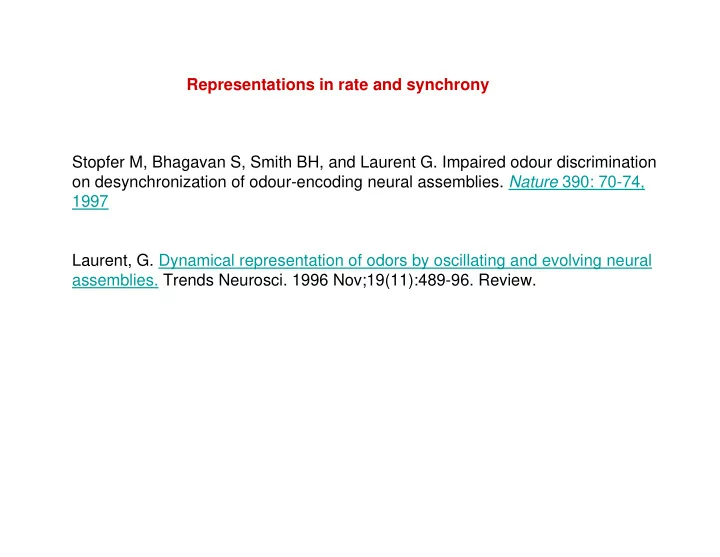

Representations in rate and synchrony Stopfer M, Bhagavan S, Smith BH, and Laurent G. Impaired odour discrimination on desynchronization of odour-encoding neural assemblies. Nature 390: 70-74, 1997 Laurent, G. Dynamical representation of odors by oscillating and evolving neural assemblies. Trends Neurosci. 1996 Nov;19(11):489-96. Review.
http://www.springerimages.com/Images/LifeSciences/1-10.1007_s00049-009-0033-7-1
http://www.sciencedirect.com/science/article/pii/S0166223698012363
http://cognition.ups-tlse.fr/pami/pamiEn.html
Correlation between activity patterns 1.0 0.8 0.6 Spatial 0.4 or 0.2 Rate 0.0 code Octanol - Hexanol - Hexanol - Nonanol Octanol Nonanol Sachse, Rappert, & Galizia, European Journal of Neuroscience 11 (11), 3970-3982.
Percentage of bees responding to a test stimulus after conditioning is a measure of generalization between odorants. C onditioned D issimilar S imilar C S D
Correlation between activity patterns Behavioral generalization 1.0 0.8 0.6 0.4 0.2 0.0 Octanol - Hexanol - Hexanol - Nonanol Octanol Nonanol Sachse, Rappert, & Galizia, European Journal of Neuroscience 11 (11), 3970-3982.
Behavioral generalization Correlation between activity patterns 0.0 0.2 0.4 0.6 0.8 1.0 Octanol - Nonanol Hexanol - Octanol Hexanol - Nonanol
Synchronization or Temporal code
Laurent G et al. J. Neurosci. 1996;16:3837-3847
Odor ( CS ) activates SNs Projection Neuron (PN) Local Interneuron (LN) Inhibitory synapse PN PN Associative Neuron (AN) 2 8 2 6 9 2 4 7 2 2 5 2 0 3 1 8 1 6 1 1 4 - 1 1 2 - 3 1 0 - 5 Sucrose ( US ) activates AN Cleland and Linster, Behav Neurosci. 2002 Apr;116(2):212-21.
Computational Model of the Antennal Lobe - Odor induced oscillations Weak input 9 7 5 3 1 - 1 - 3 - 5 Strong input 2 8 2 8 2 6 2 6 2 4 2 4 2 2 2 2 2 0 2 0 1 8 1 8 1 6 1 6 1 4 1 4 1 2 1 2 1 0 1 0 from: Stopfer et al., Nature 390, 1997. see also: Wehr and Laurent, Nature 384, 1996; MacLeod and Laurent, Science 274 , 1996.
Computational Model of the Antennal Lobe - Odor induced oscillations Weak input 9 7 5 3 1 - 1 - 3 - 5 Strong input 2 8 2 8 2 6 2 6 2 4 2 4 2 2 2 2 2 0 2 0 1 8 1 8 1 6 1 6 1 4 1 4 1 2 1 2 1 0 1 0 from: Stopfer et al., Nature 390, 1997. see also: Wehr and Laurent, Nature 384, 1996; MacLeod and Laurent, Science 274 , 1996.
S imilar D issimilar C onditioned 1 1 0 1 2 0 1 3 0 1 4 0 1 5 0 1 6 0 1 7 0 1 8 0 1 250 ms
C onditioned S imilar D issimilar D S C 1 1 0 1 2 0 1 3 0 1 4 0 1 5 0 1 6 0 1 7 0 1 8 0 1 250 ms
Percentage of bees responding to a test stimulus after conditioning is a measure of generalization between odorants. C onditioned D issimilar S imilar C S D
If inhibition is blocked, oscillations and synchrony disappear 2 8 2 8 2 6 2 6 2 4 9 2 4 2 2 7 2 2 2 0 5 2 0 1 8 3 1 8 1 6 1 6 1 1 4 1 4 - 1 1 2 1 2 - 3 1 0 1 0 - 5
In the model, odor-evoked oscillations and accompanying synchrony among AL neurons are concentration-dependent. No inhibition Inhibition 0 1 0 0 2 0 0 3 0 0 4 0 0 5 0 0 6 0 0 7 0 0 0 1 0 0 2 0 0 3 0 0 4 0 0 5 0 0 6 0 0 7 0 0 500 ms This has been shown experimentally in the locust and honeybee antennal lobe
C onditioned S imilar D issimilar 1 1 0 1 2 0 1 3 0 1 4 0 1 5 0 1 6 0 1 7 0 1 8 0 1 C S D 250 ms
Recommend
More recommend